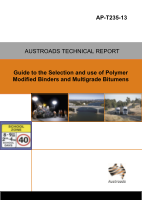Pavement

Guide to the Selection and use of Polymer Modified Binders and Multigrade Bitumens
- Publication no: AP-T235-13
- ISBN: 978-1-925037-05-0
- Published: 14 May 2013
- PDF (free) Download
This document provides a guide to the selection of modified binders including multigrade bitumens for different treatments and service conditions, and to assist in the use and interpretation of the Austroads Specification Framework for Polymer Modified Binders and Multigrade Bitumens(AGPT/T190).
- 1. INTRODUCTION
- 1.1. Purpose
- 1.2. Scope
- 1.3. Background
- 2. SAFETY AND ENVIRONMENT
- 2.1. General
- 2.2. Safety of Personnel
- 2.2.1. Burns
- 2.2.2. Fumes
- 2.2.3. Flammability
- 2.2.4. Moisture
- 2.2.5. Material Safety Data Sheets (MSDS)
- 2.3. Environment
- 3. BINDER TYPES AND CLASSES
- 3.1. Binder Properties
- 3.2. Classification of PMBs
- 3.2.1. Elastomers
- 3.2.2. Plastomers
- 3.2.3. Crumb Rubber
- 3.3. Classification of Multigrade Bitumens
- 4. SPRAYED SEALS
- 4.1. Introduction
- 4.1.1. General
- 4.1.2. Binder Selection Process
- 4.2. Sprayed Seal Type
- 4.2.1. General
- 4.2.2. High Stress Seal (HSS)
- 4.2.3. Extreme Stress Seal (XSS)
- 4.2.4. Strain Alleviating Membrane (SAM)
- 4.2.5. Strain Alleviating Membrane Interlayer (SAMI)
- 4.3. Performance Conditions
- 4.3.1. General
- 4.3.2. Traffic Loading and Site Severity
- 4.3.3. Assessment of Crack Activity and Crack Severity
- 4.4. Binder Selection
- 4.4.1. High Stress Seals (HSS)
- 4.4.2. Extreme Stress Seals (XSS)
- 4.4.3. Strain Alleviating Membrane (SAM)
- 4.4.4. Strain Alleviating Membrane Interlayer (SAMI)
- 4.4.5. Additional Applications
- 4.4.6. Summary
- 4.5. Constraints
- 4.6. Design Procedure
- 4.7. Field Application
- 4.7.1. Introduction
- 4.7.2. Adhesion and Cohesion Characteristics
- 4.7.3. Cutting Back PMB or Multigrade Bitumen
- 5. ASPHALT
- 5.1. General
- 5.1.1. Introduction
- 5.2. Performance Conditions
- 5.2.1. Traffic Loading
- 5.2.2. Pavement Condition
- 5.2.3. Cracking
- 5.2.4. Pavement Temperature Regime
- 5.3. Binder Selection
- 5.3.1. Rutting Resistance
- 5.3.2. Resistance to Fatigue Cracking
- 5.3.3. Rutting and Fatigue Resistance
- 5.3.4. Open Graded Asphalt (OGA)
- 5.3.5. Stone Mastic Asphalt (SMA)
- 5.3.6. Additional Applications
- 5.3.7. Summary
- 5.4. Mix Design
- 5.4.1. Dense Graded Asphalt Mixes
- 5.4.2. Open Graded Mixes
- 5.4.3. Stone Mastic Asphalt
- 5.5. Asphalt Production and Placing
- 5.5.1. Health and Safety
- 5.5.2. Manufacture
- 5.5.3. Spreading and Compaction
- 6. STORAGE AND HANDLING
- 6.1. General
- 6.2. Neat Polymers
- 6.3. Hot Pre-blended Binders
- 6.4. Mixing and Circulation
- 6.5. Contamination
- 6.6. Documented Storage and Handling History
- 7. SAMPLING
- 7.1. General
- 7.2. Purpose
- 7.3. Frequency
- 7.4. Sampling
- References
- Appendix A previous and current binder classifications
- Appendix B Determination of maximum Pavement Temperature (Tmax)
Related publications
AP-PWT06-14
Latest Pavement News
